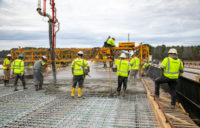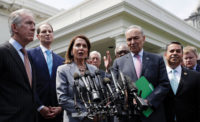House Democrats have unveiled a "framework" for a $760-billion, five-year infrastructure proposal but did not say how they plan to pay for the program or when it might move through the chamber.
The proposal, which House Speaker Nancy Pelosi (D-Calif.) and Democratic House colleagues unveiled at Jan. 29 press conference in the U.S. Capitol, spans a wide range of types of infrastructure, from highways to the electricity grid. It also emphasizes an approach that aims to address climate change. [View press conference partial transcript here.]
It includes $329 billion for highways, $105 billion for transit, $50.5 billion for clean water/wastewater treatment, $251.4 billion for drinking water and $347.3 billion for clean energy and $86 billion for broadband and other communications.
There also would be $30 billion for airports, $10 billion for water resources projects, such as flood protection and navigation amd $19.7 billion for seaports. [View fact sheet showing amounts for each infrastructure sector here.]
Pelosi said Democrats also will be working on legislation for funding school buildings and housing. Democrats didn't release funding figures for those categories, but Pelosi said those costs would be add-ons to the $760 billion.
House Transportation and Infrastructure Committee Chairman Peter DeFazio (D-Ore.), whose panel has jurisdiction over infrastructure sectors that comprise more than 70% of the plan’s dollars, said, “We have a tremendous opportunity here to do a transformative, 21st-Century infrastructure package.”
The current infrastructure network, which dates to the Eisenhower administration or earlier, is “falling apart,” DeFazio said. “It needs to be rebuilt.”
He added, “We can rebuild it in ways that are resilient, for climate change, that use more and climate-friendly materials that actually will be more durable."
House Ways and Means Committee Chairman Richard Neal (D-Mass.) said he had discussed infrastructure with Treasury Secretary Steven Mnuchin and added, “I think there’s some room here where we might be able to find a bipartisan agreement.”
But Neal said Democrats consciously are holding off on proposing how they would finance their infrastructure proposal.
Silence on revenue-raisers
He said, “I think it’s really important that we not volunteer a revenue stream until the administration reaches an agreement with us.”
Neal added, "I think that that will provide an opportunity for Republicans, and Democrats, after our committee negotiations [about] what the revenue stream ought to be, to get on with what is a sorely needed investment in America."
Asked whether they planned to assemble one large package or move multiple bills individually, the Democrats didn’t provide a definitive answer.
Three House committees would have jurisdiction over parts of the $760-billion plan, which would likely mean breaking up the total package at least somewhat, in terms of bill drafting.
Of the various sectors, surface transportation probably carries highest profile, and its authorizing legislation is the only one with a hard deadline. The current surface transportation law, the 2015 FAST Act, expires on Sept. 30. Of course, if discussions over funding or other issues hit a snag, a short-term extension is always a possibility.
The Democrats' $329 billion for highways exceeds the $287 billion over five years authorized in legislation that cleared the Senate Environment and Public Works Committee last July.
'T&I' Republicans weigh in
One day earlier, Rep. Sam Graves (Mo.) the top Republican on the "T&I" and Rep. Rodney Davis (Ill.) , ranking Republican on that panel’s highway and transit subcommittee, released a list of their own priorities, but only for surface transportation.
They include focusing on rural infrastructure, expediting project delivery and finding an alternative financing source to the fuel-tax-supported Highway Trust Fund, Graves has long been advocating the vehicle miles traveled fee.
Industry groups, including the American Road & Transportation Builders Association, Associated General Contractors of America, Association of Equipment Manufacturers and American Council of Engineering Companies, welcomed the bipartisan moves to weigh in with infrastructure ideas.
But Dave Bauer, ARTBA president and chief executive officer, said, “All policymakers and stakeholders should be clear-eyed there will be no infrastructure initiative without equivalent passion and commitment devoted to paying for these needed investments.”
Shout-out for Build America Bonds
Ways and Means held a hearing later in the day to look at ideas for paying for infrastructure investment. One item that Neal highlighted in his opening statesment, and in the press conferece, was reviving Build America Bonds (BABs).
They were created under the 2009 American Recovery and Reinvestment Act. But the bonds had a relatively short history—the program expired on Dec. 31, 2010.
BABs were taxable bonds for which the Treasury paid a subsidy equal to 35% of the interest expense to the state or locality that issued them. In all, the program sparked 2,275 bond issues totaling more than $181 billion.
Neal said at the press conference, “Nothing in the recovery act was more successful in terms of public construction and infrastructure than the use of Build America Bonds.” I want something that’s really big and I think Build America Bonds ought to be a good place to start.
Pelosi wouldn’t provide a timetable for when infrastructure legislation could come to the House floor. “We’ll go to the floor when we’re ready," she said, but added, “It won’t be soon—we're not talking about next week, or something."




